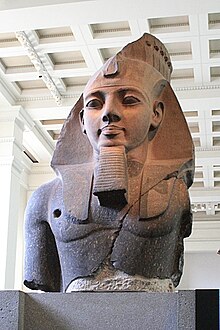
Back Ramses II AF رمسيس الثاني Arabic رمسيس التانى ARZ Ramsés II AST Рамсес II AV II Ramzes AZ Рамсес II BE Рамсэс II BE-X-OLD Рамзес II Bulgarian দ্বিতীয় রামসেস Bengali/Bangla
| Ramesses II | ||||||||||||||||||||||||||||||||||||||||||||||||||||||||||||||||||||||||||||||||||||||||||||||||||||||||||||||||||||||||||
|---|---|---|---|---|---|---|---|---|---|---|---|---|---|---|---|---|---|---|---|---|---|---|---|---|---|---|---|---|---|---|---|---|---|---|---|---|---|---|---|---|---|---|---|---|---|---|---|---|---|---|---|---|---|---|---|---|---|---|---|---|---|---|---|---|---|---|---|---|---|---|---|---|---|---|---|---|---|---|---|---|---|---|---|---|---|---|---|---|---|---|---|---|---|---|---|---|---|---|---|---|---|---|---|---|---|---|---|---|---|---|---|---|---|---|---|---|---|---|---|---|---|---|
| Ramesses the Great, Ozymandias | ||||||||||||||||||||||||||||||||||||||||||||||||||||||||||||||||||||||||||||||||||||||||||||||||||||||||||||||||||||||||||
 The Younger Memnon (c. 1250 BC), a statue depicting Ramesses II, from the Ramesseum in Thebes. Currently on display at the British Museum in London. | ||||||||||||||||||||||||||||||||||||||||||||||||||||||||||||||||||||||||||||||||||||||||||||||||||||||||||||||||||||||||||
| Pharaoh | ||||||||||||||||||||||||||||||||||||||||||||||||||||||||||||||||||||||||||||||||||||||||||||||||||||||||||||||||||||||||||
| Reign | 1279–1213 BC | |||||||||||||||||||||||||||||||||||||||||||||||||||||||||||||||||||||||||||||||||||||||||||||||||||||||||||||||||||||||||
| Predecessor | Seti I | |||||||||||||||||||||||||||||||||||||||||||||||||||||||||||||||||||||||||||||||||||||||||||||||||||||||||||||||||||||||||
| Successor | Merneptah | |||||||||||||||||||||||||||||||||||||||||||||||||||||||||||||||||||||||||||||||||||||||||||||||||||||||||||||||||||||||||
| ||||||||||||||||||||||||||||||||||||||||||||||||||||||||||||||||||||||||||||||||||||||||||||||||||||||||||||||||||||||||||
| Consort | Nefertari, Isetnofret, Maathorneferure, Meritamen, Bintanath, Nebettawy, Henutmire | |||||||||||||||||||||||||||||||||||||||||||||||||||||||||||||||||||||||||||||||||||||||||||||||||||||||||||||||||||||||||
| Children | 88–103 (List of children of Ramesses II) | |||||||||||||||||||||||||||||||||||||||||||||||||||||||||||||||||||||||||||||||||||||||||||||||||||||||||||||||||||||||||
| Father | Seti I | |||||||||||||||||||||||||||||||||||||||||||||||||||||||||||||||||||||||||||||||||||||||||||||||||||||||||||||||||||||||||
| Mother | Tuya | |||||||||||||||||||||||||||||||||||||||||||||||||||||||||||||||||||||||||||||||||||||||||||||||||||||||||||||||||||||||||
| Born | c. 1303 BC | |||||||||||||||||||||||||||||||||||||||||||||||||||||||||||||||||||||||||||||||||||||||||||||||||||||||||||||||||||||||||
| Died | c. 1213 BC (aged 90–91) | |||||||||||||||||||||||||||||||||||||||||||||||||||||||||||||||||||||||||||||||||||||||||||||||||||||||||||||||||||||||||
| Burial | KV7 | |||||||||||||||||||||||||||||||||||||||||||||||||||||||||||||||||||||||||||||||||||||||||||||||||||||||||||||||||||||||||
| Monuments | Abu Simbel, Abydos,[4] Ramesseum, Luxor,[5] Karnak[5] | |||||||||||||||||||||||||||||||||||||||||||||||||||||||||||||||||||||||||||||||||||||||||||||||||||||||||||||||||||||||||
| Dynasty | 19th Dynasty | |||||||||||||||||||||||||||||||||||||||||||||||||||||||||||||||||||||||||||||||||||||||||||||||||||||||||||||||||||||||||
Ramesses II[a] (/ˈræməsiːz, ˈræmsiːz, ˈræmziːz/; Ancient Egyptian: rꜥ-ms-sw, Rīꜥa-masē-sə,[b] Ancient Egyptian pronunciation: [ɾiːʕamaˈseːsə]; c. 1303 BC – 1213 BC),[7] commonly known as Ramesses the Great, was an Egyptian pharaoh. He was the third ruler of the Nineteenth Dynasty. Along with Thutmose III of the Eighteenth Dynasty, he is often regarded as the greatest, most celebrated, and most powerful pharaoh of the New Kingdom, which itself was the most powerful period of ancient Egypt.[8] He is also widely considered one of ancient Egypt's most successful warrior pharaohs, conducting no fewer than 15 military campaigns, all resulting in victories, excluding the Battle of Kadesh, generally considered a stalemate.[9]
In ancient Greek sources, he is called Ozymandias,[c][10] derived from the first part of his Egyptian-language regnal name: Usermaatre Setepenre.[d][11] Ramesses was also referred to as the "Great Ancestor" by successor pharaohs and the Egyptian people.
For the early part of his reign, he focused on building cities, temples, and monuments. After establishing the city of Pi-Ramesses in the Nile Delta, he designated it as Egypt's new capital and used it as the main staging point for his campaigns in Syria. Ramesses led several military expeditions into the Levant, where he reasserted Egyptian control over Canaan and Phoenicia; he also led a number of expeditions into Nubia, all commemorated in inscriptions at Beit el-Wali and Gerf Hussein. He celebrated an unprecedented thirteen or fourteen Sed festivals—more than any other pharaoh.[12]
Estimates of his age at death vary, although 90 or 91 is considered to be the most likely figure.[13][14] Upon his death, he was buried in a tomb (KV7) in the Valley of the Kings;[15] his body was later moved to the Royal Cache, where it was discovered by archaeologists in 1881. Ramesses' mummy is now on display at the National Museum of Egyptian Civilization, located in the city of Cairo.[16]
- ^ a b c d e Leprohon (2013), pp. 114–115.
- ^ a b c Tyldesley (2001), p. xxiv.
- ^ a b Clayton (1994), p. 146.
- ^ "Mortuary temple of Ramesses II at Abydos". Archived from the original on 22 December 2008. Retrieved 28 October 2008.
- ^ a b Anneke Bart. "Temples of Ramesses II". Archived from the original on 28 April 2008. Retrieved 23 April 2008.
- ^ "Rameses". Webster's New World College Dictionary. Wiley Publishing. 2004. Archived from the original on 2 October 2011. Retrieved 27 April 2011.
- ^ "Ramses". Webster's New World College Dictionary. Wiley Publishing. 2004. Archived from the original on 24 January 2012. Retrieved 27 April 2011.
- ^ Putnam (1990), p. [page needed].
- ^ Kulkarni, P., Ji, Z., Xu, Y., Neskovic, M., & Nolan, K. (2023). Exploring Semantic Perturbations on Grover. arXiv preprint arXiv:2302.00509.
- ^ Diodorus Siculus. "Diodorus Siculus, Bibliotheca Historica, Books I-V, book 1, chapter 47, section 4". www.perseus.tufts.edu. Archived from the original on 6 May 2011. Retrieved 10 October 2011.
- ^ "Ozymandias". PBS. Archived from the original on 13 December 2007. Retrieved 30 March 2008.
- ^ O'Connor & Cline (1998), p. 16.
- ^ von Beckerath (1997), pp. 108, 190.
- ^ Brand (2000), pp. 302–305.
- ^ Leblanc, Christian. "Gerard". Archived from the original on 4 December 2007. Retrieved 23 April 2008.
- ^ Parisse, Emmanuel (5 April 2021). "22 Ancient Pharaohs Have Been Carried Across Cairo in an Epic 'Golden Parade'". ScienceAlert. Archived from the original on 27 March 2022. Retrieved 5 April 2021.
Cite error: There are <ref group=lower-alpha> tags or {{efn}} templates on this page, but the references will not show without a {{reflist|group=lower-alpha}} template or {{notelist}} template (see the help page).
